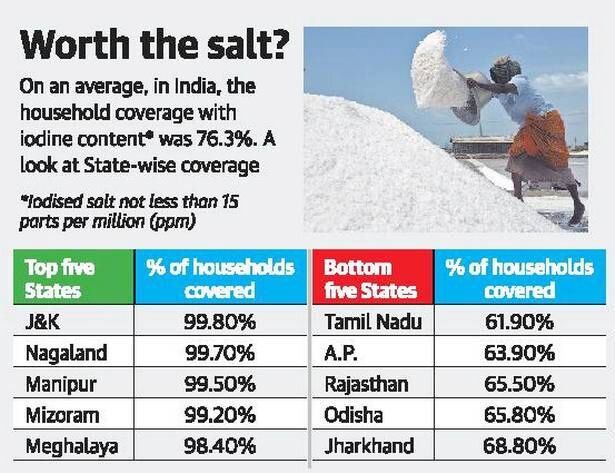Iodized Salt Coverage in India | 10 Sep 2019
According to a national survey to measure the coverage of iodized salt, Tamil Nadu had the lowest consumption of iodized salt.
- The survey was conducted by Nutrition International (a not for profit agency based in Canada) in collaboration with the All India Institute of Medical Sciences (AIIMS) and the Indian Coalition for the Control of Iodine Deficiency Disorders (ICCIDD).
- It was first of its kind, pan India survey that tested the iodine content in samples of cooking salt from households.
Key Findings
- The survey covered a total of 21,406 households across India.
- The study shows that 76.3% of Indian households consumed adequately iodized salt, (which is salt with at least 15 parts per million of iodine).
- The five worst performers were Tamil Nadu (61.9%), Andhra Pradesh (63.9%), Rajasthan (65.5%), Odisha (65.8%) and Jharkhand (68.8%).
- The North-Eastern states were doing well with respect to the consumption of iodized salt as compared to the rest of India.
- The key recommendation of the study was to sustain the momentum so that iodine coverage does not fall below current levels.
- It also recommended that the States and the Centre need to work together to address the current gaps and look into issues that vary from one state to another, in order to produce adequately iodized salt.
Iodine
- Iodine is a vital micro-nutrient for the optimal mental and physical development of human beings.
- Deficiency of iodine can result in a range of disabilities and disorders such as goitre, hypothyroidism, cretinism, abortion, still-births, mental retardation, and psychomotor defects (defects in which there is a slow down in thought process and a reduction of physical movements in an individual).
- In 1992, India made fortification of salt with iodine mandatory, for direct human consumption.
- In 2011, the Supreme Court also mandated universal iodization for the control of iodine deficiencies.
- A recent initiative in this regard named Jeevan Bindi (an iodine patch designed like a regular bindi) was started to help one lakh tribal women in north-west Maharashtra battle iodine deficiency as these tribals did not consume iodized salt.

